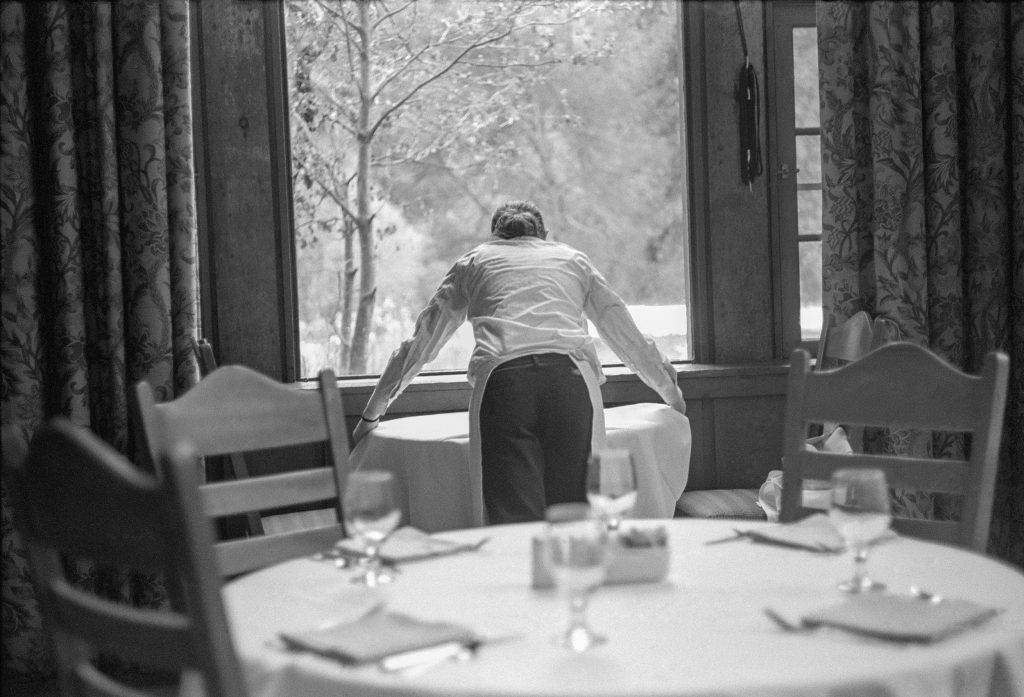Jonas Kulikauskas’ black and white photographs strike a delicate balance between ‘nature’ and man
“Yosemite People” (A Thousand Words Press, $55), is the work of award-winning LA photographer and artist Jonas Kulikauskas.
“My parents were Lithuanian refugees from World War II. Both of them lived in displaced persons’ camps in Germany for four years. They often had to uproot and move from one location to another. So that’s deep in my genes.
“For years I’ve set aside the first week of the new year as a time of special reflection, partly because January 4 is my sobriety date.”
For Y2K, he went to Zion in Utah.
Zion is packed in summer and relatively empty in winter.
He liked the phenomenon. He liked mingling with the locals. He liked that after he’d gone a few times, he had a sense of belonging.
He went to Zion every January for the next 13 years.
But in 2014 he was ready for a change. So on New Year’s Day he ended up at the Ahwahnee Hotel in Yosemite Valley.
He was struck one morning by the sight of a dining hall server carefully shaking out, laying in place, and smoothing the creases of a white tablecloth. He got a perfectly framed shot of her back with a view through the opposite 16-foot window of filigreed trees.
He ended up returning more than 20 times in the next two years — “to bring his street photography to the wilderness,” as he puts it.
“When I think of nature, I always think of God.” But what’s arresting about his photos is the delicate balance between “nature” and man.
A heavenly shaft of sunlight piercing the trees and landing softly on … a stop sign.
A middle-aged woman curled up, exhausted, on a sofa in the Ahwahnee’s Great Lounge.
A cashier, flanked by souvenir key chains and shelves of booze, at the Curry Village Gift Shop.
At the beginning he had to decide which camera to use. He settled on a Leica M6, 35mm black and white.
“I kept it black and white as kind of a springboard from Ansel Adams. But he used large format cameras with an 8x10 negative, whereas a 35mm is quick and maneuverable. For the most part Adams was shooting nature and he chose the right camera for that. But it was important that I wasn’t trying to do the same thing he was.”
Human bodies put the scale of Yosemite into perspective. A heavy-set woman marooned on a rock and dwarfed by the massive escarpments at Lower Yosemite Falls becomes tiny, vulnerable, tentative, a stand-in for all of us: a little self-conscious in the face of such majesty.
You’ve taken time off from work, booked a room, packed the cooler, driven hours. What do you do when you finally arrive? The same things people have been doing at Yosemite for a hundred years: write your name in the snow, hug your girlfriend, sit in a rocking chair, and try your hand at whittling.
In the hands of Kulikauskas, however, these homely activities attain a quiet grandeur, a faint sheen of the sacred. The effect, even when people are climbing, hiking, or interacting is of silence, stillness, the inward gaze.
“My parents are big believers in a Lithuanian phrase, “savarankiška,” which means “by your own hand.” It’s a roll up your sleeves mentality, get things done, be involved.”
So at different times he stayed in a tent, in his pickup, in hotels outside the park. He couldn’t in all good conscience just have gone a couple of times in summer, stayed in a nice hotel and gotten his shots of Half Dome. He had to climb Half Dome.
He also realized that to make a better book, he wanted stories. He ended up talking to, among others, a former Badger Pass ski instructor, a park ranger who gives bear tours, and a climber who was crushed by a three-ton boulder and rescued. He has a special heart for the 5,000 deeply committed contract employees who live on-site.
The project hardly ended there.
A chance meeting at the Rose Bowl Flea Market led to State Librarian Kevin Starr contributing a 2,000-word essay called “Yosemite Memories.”
“A real gentleman. That was truly an honor. He died just a few weeks later.”

Jonas Kulikauskas with his Kodak 2D 8x10 camera at Capitol Reef National Park. (MATAS KULIKAUSKAS VIA A THOUSAND WORDS PRESS)
Recently, Kulikauskas was invited to include his photos in the permanent collection of a major U.S. museum, and anticipates making an exciting announcement in 2019.
But maybe his favorite Yosemite story concerns a person whose likeness he never captured on camera.
“They had a few recovery meetings at the park a week, very sparse attendance. One night I showed up at the place, but the door was locked. It was pitch black out.
“Whoever was supposed to open up hadn’t shown, but another guy did, a visitor from Colorado. We commiserated, and then I said, ‘Do you just want to have a meeting, you and I?’ And we did. We took turns and shared and it was so dark I couldn’t see his face. It was so satisfying. Really good for the soul. We both felt it. Afterward, we went our separate ways. And I never saw his face. It was like being in the confessional.”
Heather King is a blogger, speaker and the author of several books. For more, visit heather-king.com.
SPECIAL OFFER! 44 issues of Angelus for just $9.95! Get the finest in Catholic journalism with first-rate analysis of the events and trends shaping the Church and the world, plus the practical advice from the world’s best spiritual writers on prayer and Catholic living, along with great features about Catholic life in Los Angeles. Subscribe now!

